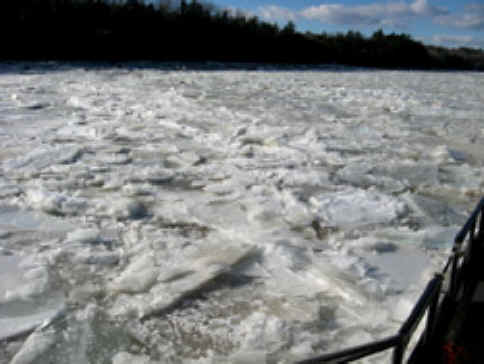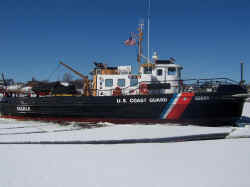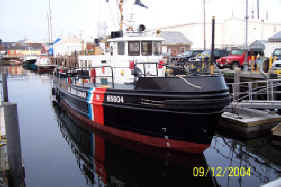Coast Guard Cutter TACKLE Smashes
Ice on Maine’s Penobscot River
By Bob Trapani, Jr.

Photo by Bob Trapani, Jr.
A view of thick ice on the Penobscot
River along Bald Hill Cove
Winter 2008-09 came in like a roaring lion along
the coast of Maine, with a powerful snowstorm blanketing the
region on December 21st; followed by a blast of arctic air on
January 1st, which was armed with icy wind chills in the minus
teens that caused people to ‘run for warm cover’ on New
Year’s Day 2009.
While the snow itself has since come and gone to
various extents, the gripping effect of winter’s handiwork has
remained firmly entrenched. For places like Maine’s Penobscot
River it has transformed the mighty river’s surface water into a
frozen state from Bald Hill Cove above Winterport to the head of
navigation in Bangor at the Interstate 395 Bridge.

USCG Photo
U.S. Coast Guard cutter TACKLE
(WYTL 65604) breaking ice on the
Penobscot River
The Penobscot River obviously still flows during
the winter months, rising and falling on the daily tides, but for
residents along the City of Brewer’s eastern shore and the City
of Bangor’s western shore – some 22 miles north above the
river’s entrance, they would be hard pressed to know without the
domestic icebreaking efforts of the United States Coast Guard.
On January 5th and 6th, 2009, the 65-foot Coast
Guard cutter TACKLE, which is homeported in Rockland, Maine, and
under the command of officer-in-charge BMC John Anders, set out to
do one of the things the ship and crew does best – crush ice.

Photo by Bob Trapani, Jr.
The TACKLE encountered the first
signs of ice on the river a few miles above
the City of Bucksport where a lighted
ice buoy held station in an icy floe
The TACKLE’s crew knew in advance there was
plenty of ice on the river near Bangor, but exactly where they
would first encounter frozen resistance was the question. The
ship’s journey from Rockland to the mouth of the river at Fort
Point, then passing northward under the imposing Penobscot
Narrow’s Bridge to the City of Bucksport, was nothing but clear
sailing.
The first sign of winter’s icy grip on the
river was spotted north of the Frankfort Flats, a few miles above
Bucksport, where accumulated ice had fastened itself to the steel
hull of a lighted ice buoy, and covering a good stretch of water
around the vicinity of the navigational aid.
The TACKLE then transited by the quiet Town of
Winterport, and eventually past Bucks Ledge with its historic
daybeacon standing silent sentinel over a rocky navigational
hazard, but still there were no other signs of serious ice on the
river to this point.

Photo by Bob Trapani, Jr.
The Cianbro facility in Brewer can
be seen distance as the TACKLE works
its way north on the river
Finally, the first formidable floes were
encountered along the Bald Hill Reach section, approximately 10
miles south of Bangor. The frozen mass stretched completely across
the width of the Penobscot River from here northward, encasing the
riverbanks in an icy, wretched grip and blocking the waterway’s
shipping lanes.
From this point, the ship’s smooth, flat ride
was but a memory; replaced by the ceaseless resistance of ice
against the ship’s bow and collisions with larger, more stubborn
hummocked ice floes, all of which created a raucous din in the air
as the cutter plowed through the frozen wasteland.
According to a January 7, 2009 U.S. Coast Guard
press release, “The cutters are maintaining a track through the
ice so a barge can transit to the Cianbro facility in Brewer,
Maine, in late February.”

Photo by Bob Trapani, Jr.
BMC John Anders, officer-in-charge
of the cutter TACKLE navigates the
ship through fields of ice
“The ice breakers will maintain the channel on
a weekly basis until the barge makes its scheduled delivery,”
said Chief Warrant Officer Jeff Chase, the aids to navigation
officer at Coast Guard Sector Northern New England. “Once the
barge departs about a week later, the Coast Guard crews will head
to the Kennebec River and break ice to help prevent flooding.”
BMC John Anders touches on the challenges of
maintaining an effective track through the ice, saying, “When
breaking up fast ice, you need to ensure that you do so during the
beginning stage of the ebb tide and leave a wide enough area down
river for the ice to flow freely.”
Anders went on to note, “Typically the ship
can make one pass through an area, with the ships wake creating a
wide enough path. The challenge arises when we encounter increased
ice thickness caped with snow. The snow creates a significant
amount of friction and can often halt the ships momentum within a
mere thirty feet. We have experienced ice chocked areas where it
takes us nearly four hours to get a 400 yard stretch of the river
moving.”

Photo by Bob Trapani, Jr.
There are a variety of ice types
that can encountered during
icebreaking, with hummocked
ice being the predominant
type the TACKLE crushed
during this operation
There is the obvious practical side of domestic
icebreaking in regards to the importance of these annual
operations to the state of Maine and its coastal interests, but
there is also an interesting side as well related to what happens
to ice after sudden impact with an icebreaker.
Every moment upon which the TACKLE’s rugged
bow smashes into fields of ice it never fails to produce a wide
range of reactions depending on the thickness of the floes, but
all of which end up being of the broken variety for the doomed
sheets of rime in the path of the determined cutter.
The power of the ship against stressed, thinner
ice often causes a ‘popping’ or ‘shattered glass’ sound,
while cracks in the ice race wildly away from the ship and across
the floes faster than the eye can follow.
Air bubbles also randomly ‘blow’ water
through weakened stretches of floes and chunks of crushed ice are
sent sliding furiously across unbroken sections, but invariably
within split seconds, large crevices appear and separate the
impacted masses from each other like a jagged jigsaw puzzle.

Photo by Bob Trapani, Jr.
The TACKLE plows through
floes, sending crushed ice flying
With thicker ice, the moment of impact creates
more of a hideous grinding sound in the air, which is caused by
the resistance of the floes against the TACKLE’s steel bow and
forward motion. Stark ‘bangs’ also occasionally interrupt the
dominant sound and feel of scrapping friction as hefty sections of
broken ice flow free and slam the underside of the ship.
Since thicker ice tends to reduce the ship’s
speed (between 2 & 6 knots), the crushed ice floes teeter a
moment against the bow upon impact rather than simply shatter,
often times rising up on end to reveal their impressive thickness,
before being submerged underwater by the ship’s powerful wake in
a chilling ‘death plunge’ of sorts.
During times of heavier domestic icebreaking
operations, the forward motion of cutters like the TACKLE is
anything but normal. The ship often deflects ever so slightly to
the left or right following a collision with a solid floe, or
momentarily ‘rides up’ upon the frozen rime. When this occurs,
the ship repeats a ‘stop, reverse, forward’ sequence of
ramming motion to break the stubborn ‘will’ of the ice.

Photo by Bob Trapani, Jr.
A view of the ship's path, which was
momentarily impeded by thick ice, before
the ship stopped, moved in reverse,
then ahead in a forward motion that
broke through the stubborn floes
At one point during the January 6th operations
on the Penobscot River, after the TACKLE had made multiple passes
up and down a particular section of the waterway cutting up the
ice, BM1 Keith Nichols, who shared helm duties with BMC Anders,
noted, “It’s moving – it’s opening up all over the
place.”
Assessing the broken ice flowing free on the ebb
tide, Fireman Austin Brummett noted, “It’s pretty chewed
up,” which prompted BM1 Nichols to say, “Our job is done here
– let’s head to the next one.” The broken ice was
‘running’ on the ebb tide down river away from the choked-up
sections of the Penobscot, and would eventually flow harmlessly
out to sea.
This type of scene will be repeated time and
again this winter, but the cutter TACKLE isn’t always alone on
the Penobscot River during winter icebreaking operations as it was
on January 5th and 6th. The ship is often the benefactor of vital
teamwork provided by other Coast Guard assets in the area.

Photo by Bob Trapani, Jr.
A view of crushed ice floes 'running'
toward the sea on the ebb tide
Tenacity and skill is the name of the game when
it comes to staying on top of icebreaking operations on Maine
rivers like the Penobscot and Kennebec, something the TACKLE,
along with its fellow cutters, the 140-foot THUNDER BAY from
Rockland, the 65-foot BRIDLE from Southwest Harbor and the 65-foot
SHACKLE from South Portland, excel at with great pride and
consistency.
Together this black-hulled convoy of icebreakers
fulfills the Coast Guard’s mission to clear a navigable path
through frozen rivers, ensuring that important commerce interests
can reach their destination or that critical flood control
measures are enacted, all for the good and well-being of Maine
residents and our nation as a whole.
USCGC TACKLE: 2009 Icebreaking
Operation the Penobscot River...

Photo by Bob Trapani, Jr.
The USCGC TACKLE
approaches the
imposing Penobscot Narrows Bridge
|
|

Photo by Bob Trapani, Jr.
A view of both the
new Penobscot
Narrows and old Waldo-Hancock bridges
|

Photo by Bob Trapani, Jr.
A view of the historic
Bucks Ledge
Daybeacon 20...the TACKLE encountered
ice on the river north of this point
|
|

Photo by Bob Trapani, Jr.
The TACKLE prepares
enters the first
of the ice floes on the Penobscot River,
north of Bucks Ledge Daybeacon 20
|

Photo by Bob Trapani, Jr.
Ice floes break apart in
the
wake of the TACKLE
|
|

Photo by Bob Trapani, Jr.
A view of clear and
snow-covered
ice on the river
|

Photo by Bob Trapani, Jr.
The sun sets in the
evening sky
over the frozen Penobscot River
|
|

Photo by Bob Trapani, Jr.
A close-up view of
crushed ice
in the path of the TACKLE
|

Photo by Bob Trapani, Jr.
The evening colors in
the sky reflect
off the ice south of Bangor
|
|

Photo by Bob Trapani, Jr.
The evening colors in
the sky reflect off
the ice south of Bangor
|

Photo by Bob Trapani, Jr.
A night view of the
thick ice on the
Penobscot River just south of the
Interstate 395 Bridge in Bangor
|
|

Photo by Bob Trapani, Jr.
The TACKLE retraces
its path through
the river's channel on the morning of
1/6/09 after it re-froze overnight
|

Photo by Bob Trapani, Jr.
A view of the Penobscot
River's
western shore at Bangor, with the
I-395 Bridge in the distance
|
|

Photo by Bob Trapani, Jr.
A view of ice floes
broken free
and giving the appearance of a giant
jig-saw puzzle
|

Photo by Bob Trapani, Jr.
The TACKLE crushes thick
ice floes along Bald Hill Cove
on the Penobscot River
|
|

Photo by Bob Trapani, Jr.
A view of thick ice
floes that
jammed-up a section of the
Penobscot River
|
|

Photo courtesy Bob Trapani, Jr.
Crew of the U.S.
Coast Guard Cutter
TACKLE (WYTL 65604)
(Back Row L to R) MK2 Eugene Peters,
BM1 Keith Nichols, BMC John Anders &
MKC Sam Hoy (Front Row L to R)
Auxiliarist Bob Trapani, Jr.,
FN Austin Brummett,
SN Dan Kimbrell & SA Matt Goode
(not pictured: SN Manny Sabat)
|
|
Posted: January
2009
Reprinted from uscg_ice09_penobscot.htm


















